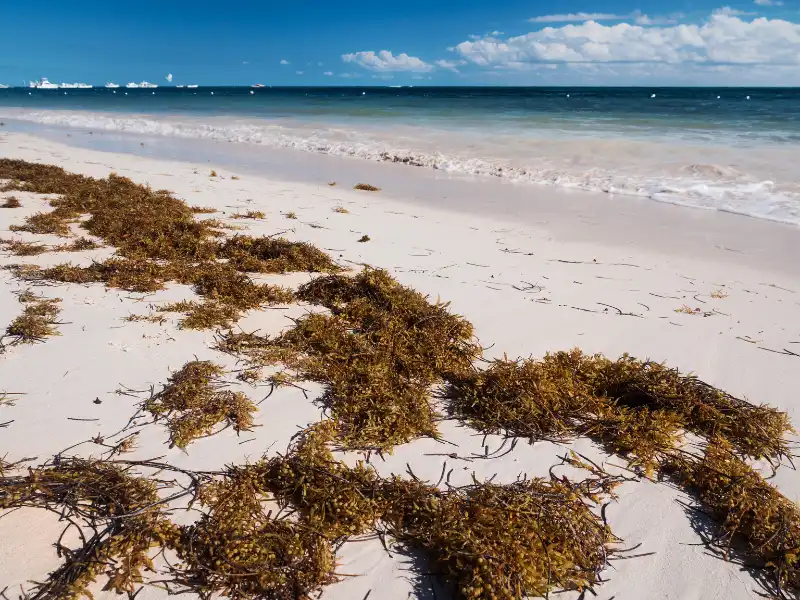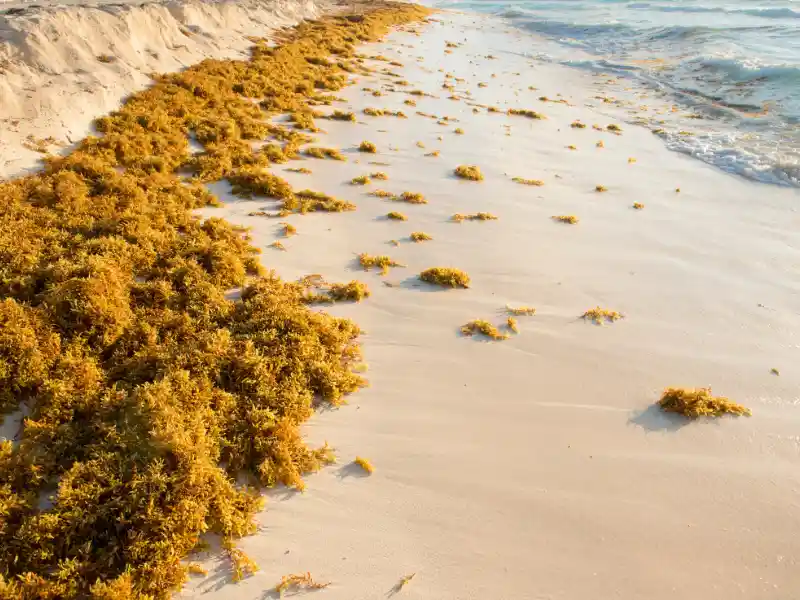Does Aruba have a sargassum seaweed problem in 2022? This should be your first question if you are a beach lover planning a trip to Aruba. In fact, if you’re considering a vacation to any Caribbean destination, you should be aware of the current sargassum seaweed conditions.
In January 2018, a significant amount of brown seaweed known as sargassum engulfed the shoreline of several Caribbean islands, turning their once-pristine white sand beaches into brown, stinging places.
This is known as the Great Sargassum Disaster of 2018, and it has had a tremendous impact on the tourism industry and local businesses. In fact, some Caribbean countries, such as Barbados, had declared a national emergency to deal with this disaster.
Since then, sargassum seaweed has been a big problem for the Caribbean islands and the millions of tourists that visit each year. Although this sargassum seaweed originates thousands of miles offshore in the sargasso sea, it travels to the Caribbean islands with the help of ocean currents.
Even today, several Caribbean islands, including Barbados, the Dominican Republic, St Lucia, and Tobago, frequently report large chunks of this stinging seaweed on their beautiful pristine beaches, frustrating both tourists and locals.
Often, tourists arrive on Caribbean islands excited, anticipating a wonderful beach vacation, but soon get upset when they find the brownish stinging seaweed on the beaches.
Therefore, before planning your Caribbean vacation, you should check whether the Caribbean island that you are going to visit has a sargassum problem or not. You should keep an eye on the sargassum warnings and forecasts and plan accordingly.
Does Aruba have Sargassum Seaweed Problem?

| Places to Avoid (Sargassum-infested places) | North Shore of Aruba |
| Places to go (Sargassum free places) | Apart from the north shore, almost the entire Aruba is free from Sargassum seaweed |
| Best beaches (free from sargassum) | Palm beach, Eagle beach, Baby beach |
| Last Major Sargassum seaweed incident in Aruba | May 2019 on the north shore |
Table of Contents
Which region in Aruba is affected by sargassum?
Aruba is one of the best vacation destinations in the Caribbean if you wish to avoid beaches infested with sargassum. Its main beaches like Palm beach, Eagle beach, and Baby beach are outside the sargassum seaweed belt.
However, seaweed does occasionally wash up on Aruba’s north shore, carried by the ocean currents. However, it has no direct effect on tourists, as Aruba’s most popular beaches are located on the island’s western and southern coasts.
In other words, the north shore of Aruba is the only place where sargassum may be an issue.
Related Posts
✅ Cancun SEAWEED Conditions [2022]: A Detailed Guide!!
✅ Tulum SEAWEED Conditions [2022]: A Detailed Guide!!
✅ Playa del Carmen SEAWEED Crisis [2022]: A Detailed Guide!!
✅ Punta Cana SEAWEED Problem (2022): Everything You Need To Know!!
✅ Isla Mujeres SEAWEED Problem in 2022? Everything You Need to Know!
✅ Cozumel SEAWEED Problem (2022): Everything You Need To Know!
What region in Aruba is Sargassum free?
Fortunately, Aruba’s north shore is not touristy, and the majority of the island’s resorts and main beaches, including Palm beach, Eagle beach, and Baby beach, are located on the island’s western and southern shorelines.
Even Aruba’s most popular snorkeling and swimming locations are located on the island’s western and southern shorelines. As a result, no one ventures to Aruba’s north coast.
Therefore, if you are vacationing in Aruba and intend to stay on the western or southern shores of the island, away from the north shore, you do not need to be concerned about sargassum seaweed.
In fact, even on Aruba’s north shore, the sargassum problem is quite rare and moderate, far less so than in Florida or Mexico.
However, as we all know, it is difficult to say anything certain about mother nature.
Sargassum seaweed is difficult to track, and it is possible that it could wash up on Aruba’s shores as a result of ocean currents.
Thus, before planning your Aruba vacation, you should be aware of the current seaweed conditions and forecasts in Aruba and plan accordingly.
Related Posts
✅ Florida Seaweed Problem 2022: Everything You Need to Know!
✅ Puerto Rico Seaweed Problem 2022: Everything You Need to Know!
✅ Belize Seaweed Problem 2022: Everything You Need to Know!
✅ Jamaica Seaweed Problem (2022): Everything You Need To Know!!
✅ Turks and Caicos Seaweed Problem 2023: Everything You Need to Know Before You Visit!
Is Sargassum seaweed harmful to humans?
While in water, sargassum seaweed is normally harmless to humans. But as soon as it hits the beach, it begins to rot.
The decaying thick layers of sargassum subsequently attract flies, killing a large number of trapped marine creatures.
This brown seaweed ruins the beauty of the Caribbean’s pristine white sand beaches and its diverse marine life. This seaweed’s rotten egg odor makes swimming nearly impossible and very unpleasant. Swimming in this sargassum seaweed-affected water can also be harmful to the human body.
When did the most recent Sargassum Seaweed incident in Aruba occur?
For those who want sargassum-free beaches, Aruba is definitely a much better vacation destination as compared to other Caribbean islands. Sargassum is quite rare in Aruba.
The last noticeable big masses of sargassum seaweed were detected on the north shore of Aruba in May 2019. Besides that, no major sargassum seaweed event has been reported in Aruba in the last three years.


I visited eagle beach yesterday and my and my son got bit up bad by sand fleas!!! Baby beach by far has been THE BEST.
Thanks, Megan. Thanks for sharing.
Have you ever visited the island of
Sint.Maarten? Part Dutch and Part
French.
Thank you for the seaweed report about Aruba!
I live in Colombia, South America. San Andres Island is much less expensive as an alternative, BUT who wants to visit where the seaweed on the shore is plentiful.
Your Welcome Pat! I hope the situation gets better till the end of this year.